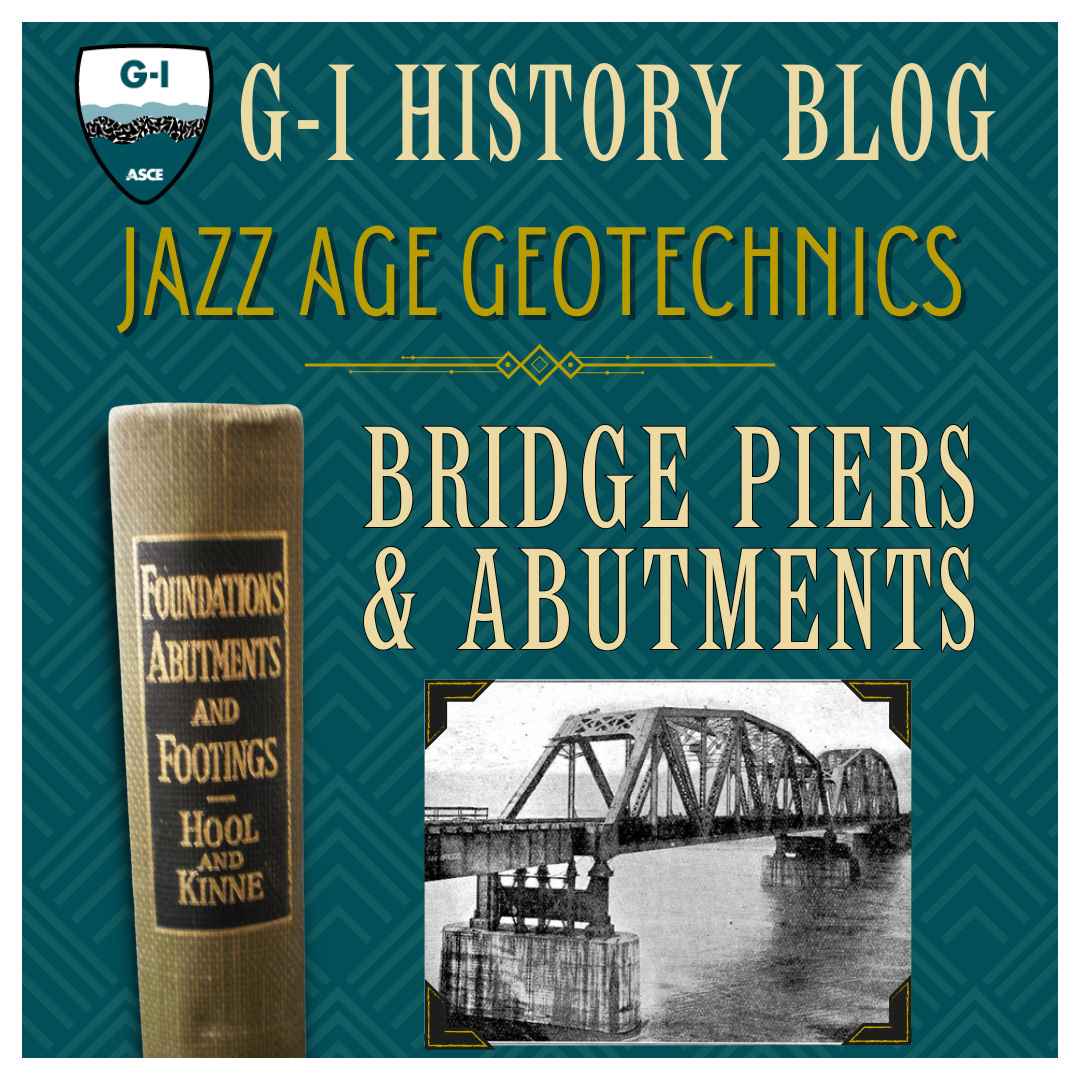
Review: Foundations, abutments and footings (Hool and Kinne, Eds., 1923), Section 7 (Bridge piers and abutments), featuring the Baltimore and Ohio Railroad as a case study
By Michael Bennett, P.E., M.ASCE (Virginia Tech: Blacksburg, VA)
Innovation and invention go hand in glove with civil engineering, as the shared roots of the words “engineer” and “ingenuity” reflect. The need for civil engineers to innovate generally arises from a combination of two factors. The first is the gap between what works on paper and what works on a job site. Rookie geo-professionals learn quickly that their early years in the workforce help them learn all the steps that lie between and around the theories and formulas they’ve learned as students. They soon become seasoned at choosing methods of calculation, selecting construction means and methods, and preparing reports, all of which helps them appreciate how much room these interstitial spaces of practice provide for engineering innovation. T.S. Eliot stated this point lyrically in his poem The Hollow Men:
“Between the idea
And the reality
Between the motion
And the act
Falls the Shadow.”
Rev. Benjamin Brewster, an Episcopal bishop, put it more humorously:
“In theory, there’s no difference between theory and practice, while in practice, there is.”
The quote is often misattributed to baseball legend and part-time philosopher Yogi Berra. In fairness, he freely acknowledged that this often happened to him, once observing, “I really didn’t say everything I said” (Eliot 1925, FG 2012, QI 2012, QI 2018, TAMU 2024).
The profit motive to reduce costs or increase returns has been the most powerful engine driving technical innovation ever since the dawn of capitalism. Sometimes, it drives those engines quite literally...
The other main catalyst for civil engineering innovation and creativity is what Karl Marx, a far more astute historian than political philosopher, memorably called “the dull compulsion of economic relations.” The profit motive to reduce costs or increase returns has been the most powerful engine driving technical innovation ever since the dawn of capitalism. Sometimes, it drives those engines quite literally, as it did on US railroads in the early and mid-19th century. American civil engineers originally imported the earliest components of railroading technology, such as track structures and signaling systems, directly from the UK. Yet they soon realized that their country’s larger size, lower population density, and more rugged terrain meant their railroads needed much lower operating costs per mile to stay in business than European lines, and they quickly got busy applying their Yankee ingenuity. Accordingly, the late 19th and early 20th centuries were a golden age of theoretical and practical innovation by US railroad civil engineers, and their publications on their work filled American and international civil engineering journals (Marx 1867, Rizzo 2004).

Source: Thayer (1892).
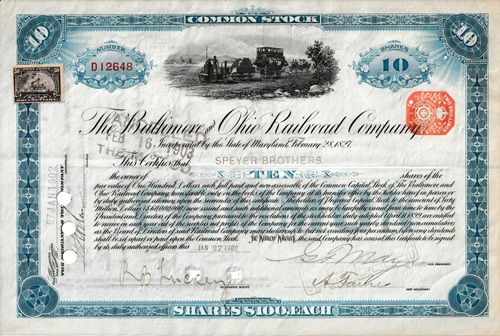
Source: Author’s collection.
American railroads that failed to innovate enough went bankrupt or were gobbled up by rivals or robber barons. However, a few not only survived but thrived through a combination of hard work, innovation, business savvy, and sheer luck. One that came out on top was the Baltimore and Ohio Railroad, popularly known as the B&O. Modern Americans know the line from the boardgame Monopoly, but its creative talents were far more Boardwalk than Baltic Avenue in caliber. Chartered in 1827, the B&O grew through careful, incremental expansion, technical ingenuity, and shrewd partnerships with other similarly sized railroads (such as the Reading, its Monopoly mate). Eventually, it connected New York City and Washington, DC to Chicago and St. Louis via crack passenger trains such as the Royal Blue (York 1987).
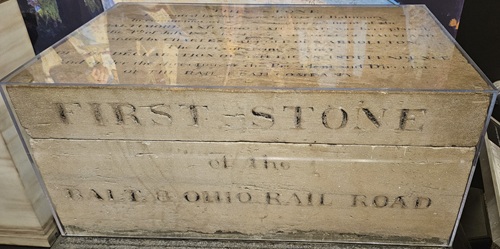
Source: Author.
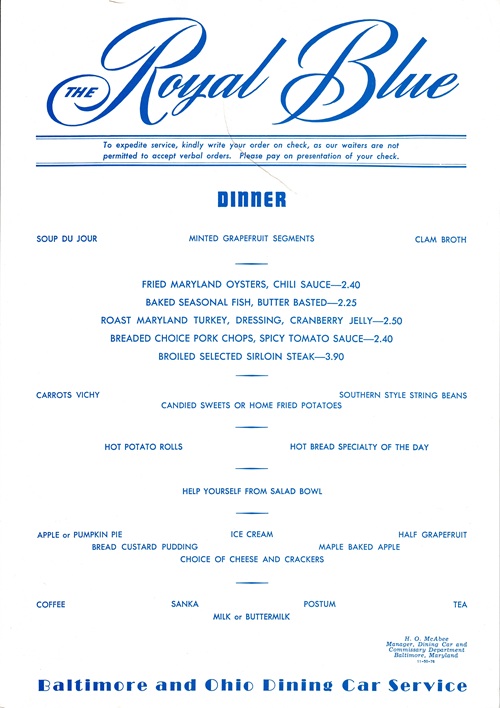
Source: Author’s collection.
The B&O’s innovative streak first emerged in the early 1830s, when it became one of the earliest US railroads to use locomotives rather than horses to power its trains. At around the same time, it introduced to its passenger trains – themselves a novelty at the time – cars that incorporated wheels and axles mounted on swiveling trucks, not directly on the car bodies. The trucks allowed the cars to pivot in transit, enabling them to round curves more easily and safely. Meanwhile, the B&O began mounting the axles of its cars and locomotives in journal boxes, early roller bearings that allowed them to rotate far more freely and without friction than did the conventional body-mounted axle brackets of the day. In 1844, Samuel Morse strung his first telegraph wire and sent the first message crackling in his eponymous code along B&O tracks between Baltimore and Washington, cementing an iconic look for American railroads. As the decades rolled by like a highballing express past country fields, the B&O also became the first railroad to use eight-wheeled passenger cars and iron boxcars (Fenton 2004, York 1987).
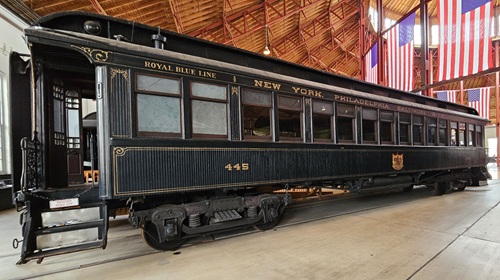
Source: Author.
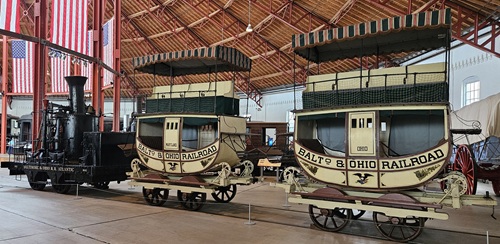
Source: Author.
As the B&O crept steadily westward, its feats of infrastructure engineering were just as notable as its improvements in rolling stock and engine power. In designing and building its route in the 1830s and 1840s, the railroad became one of the first American employers to maintain its own workforce of engineers rather than simply renting the services of US military engineers. (At the time, engineering had yet to be divided into its modern disciplines.) The B&O’s civil engineers calculated that the rugged Allegheny Mountains between Cumberland, Maryland and Wheeling, Virginia (now West Virginia) could be overcome using track with a 2.2% grade, or 116 feet of climb per mile – much steeper than anything European railroads had attempted. They then successfully designed both the route and locomotives that could surmount it. To this day, 2.2% remains the maximum grade used by American railroads. When the B&O’s early masonry bridges proved too costly, its engineers developed designs for, and built, sturdy wooden trusses to lower construction costs without sacrificing strength. Eventually, they replaced these with iron trusses, another first, for enhanced durability and fire safety. All the while, the B&O developed fundamentals of railroading operations and management ranging from statistics such as the ton-mile to publicly available timetables for passenger trains. Collectively, its innovations helped transform the United States from an agricultural nation of widely dispersed communities into an industrial powerhouse with a centralized, closely interconnected economy (Fenton 2004, Hankey 2002, York 1987).
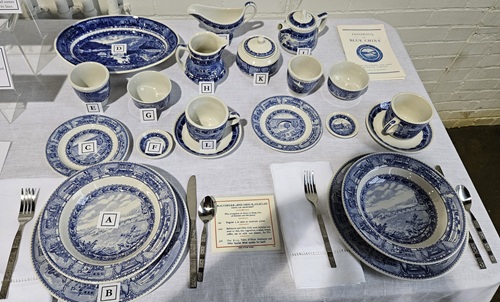
Source: Author.

Section 7 of Foundations, Abutments and Footings showed off the B&O’s cutting-edge technical acumen but simultaneously reflected how much remained to be learned in civil engineering. Part of Section 7 was written by Chicago bridge engineer Hugh Young, about whom contemporary sources reveal little. His discussion of the counterweight pits of lift bridges, swing bridges, and draw bridges is conspicuously light on geotechnical considerations and detailed calculations. It seems likely that Young’s portion of Section 7 tacitly touched on a subject of keen interest to the B&O and, indeed, most civil engineering firms and professionals of any era – how to appropriately balance engineering innovation and advancement with trade secrecy. For decades prior to the 1920s, most US civil engineers had generally held, as one historian noted, that “minding one’s own business was … among the basic rules of business” (Lang and Young 1923, Marquis 1922, McCullough 1972).
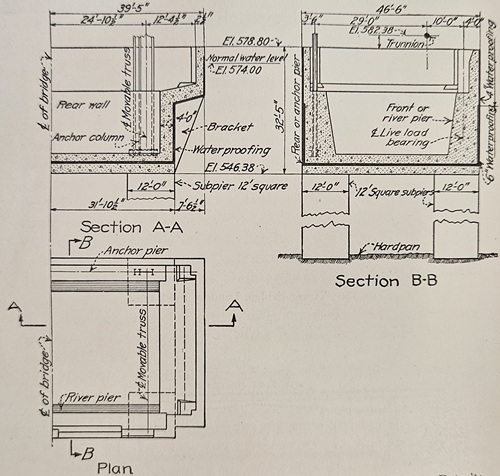
Source: Lang and Young (1923).
This point of view held that a more open, collaborative spirit of inquiry was necessary to help civil engineering tackle some of its longest-standing and most intractable problems.
Young’s vagueness in his part of Section 7 carries with it echoes of the school of thought that favored trade secrecy over the more widespread distribution of knowledge within American civil engineering. Such an opinion was and remains wholly reasonable, and plenty of his peers in the Jazz Age felt this way. However, by the 1920s, another perspective on the topic was coming into vogue. This point of view held that a more open, collaborative spirit of inquiry was necessary to help civil engineering tackle some of its longest-standing and most intractable problems. Lazarus White, co-author of Section 3 of Foundations, Abutments and Footings, and Edmund Prentis, author of Section 5, ably articulated this newer philosophy in the introduction to their 1931 book Underpinning:
“Some of the methods, appliances, and machinery described [herein] are the result of a great deal of experimental work by the authors themselves and by the staffs of their companies, involving a considerable expenditure of time and money. They might be considered trade secrets, although some are covered by patents. Nevertheless, they are published here – even at the risk of losing the trade advantage of methods known only to the authors – one compensation to them being the feeling that they have perhaps benefited the profession to which they owe so much” (Prentis and White 1931).
During their first meeting, White – tongue firmly in cheek – told Terzaghi it would be a “good investment” for his firm, Spencer, White, and Prentis, to buy every copy of Terzaghi’s book Erdbaumechanik and dump them all into the Hudson River because the manuscript told the competition too much.
White’s perspective was most likely a key reason he and Karl Terzaghi, who had a similar mindset, became fast friends when they met in 1925. During their first meeting, White – tongue firmly in cheek – told Terzaghi it would be a “good investment” for his firm, Spencer, White, and Prentis, to buy every copy of Terzaghi’s book Erdbaumechanik and dump them all into the Hudson River because the manuscript told the competition too much. Terzaghi got the joke, but the underlying question of how much of a profession’s body of knowledge should be publicly available and how much may be kept privately as trade secrets is quite serious, and geo-professionals debate it to this day. Research consortiums and open-access journals are among current solutions that accelerate civil and geotechnical engineering advances while also respecting trade secrecy and considerations of intellectual property. In such an informational climate, Hugh Young’s portion of Section 7 might have read quite differently (Goodman 1999).
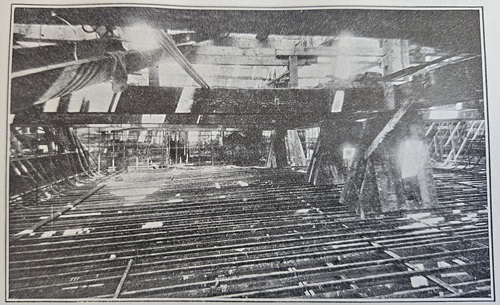
Source: Lang and Young (1923).
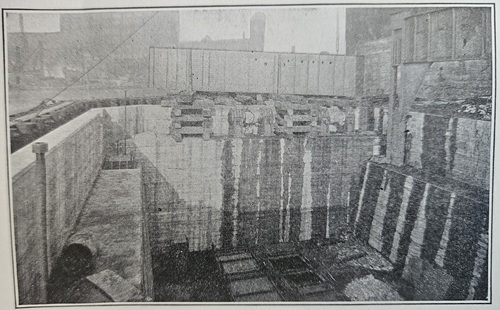
Source: Lang and Young (1923).
Most of Section 7 of Foundations, Abutments and Footings was authored by Philip Lang, one of the Baltimore and Ohio Railroad’s bridge engineers. His discussion of the design and construction of bridge piers and abutments was far meatier in terms of technical content than Hugh Young’s write-up. Lang had spent 15 years with the B&O by 1923, working his way up from a draftsman to one of its chief bridge engineers. In 1922, he had penned an article for the Transactions of ASCE on the design and construction of the railroad’s Allegheny River bridge in Pittsburgh. Lang, the B&O’s engineer of record on the structure, had pulled off devilishly tricky feats of construction sequencing in building the bridge and transferring traffic over from its predecessor while minimizing disruptions to freight and passenger service. Lang, a prolific technical writer, had also contributed pieces to Engineering News-Record, Railway Age, and General Electrical Review magazines and had authored several textbook sections. The B&O always capitalized heavily on its history and its reputation for innovation as selling points; its first rail had been laid in 1828 by Charles Carroll, the last surviving signatory to the Declaration of Independence. Thus, it probably supported Lang’s technical writing because it recognized the value his innovations provided – not to mention his work’s value as a marketing tool to trumpet the B&O’s embrace of engineering advances (Hankey 2002, Lang 1922, Marquis 1922).
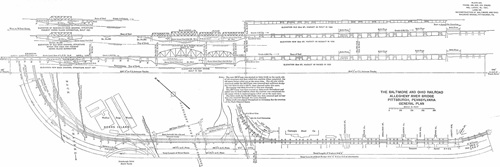
Source: Lang (1922).
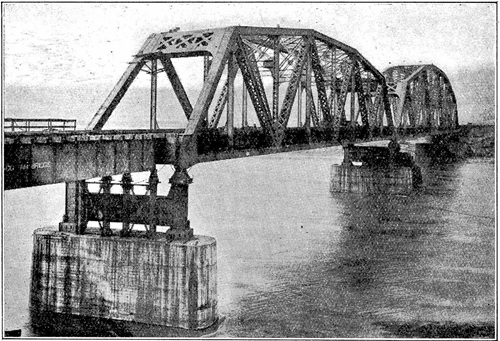
Source: Lang (1922).
At times, Lang’s writing closely paralleled modern structural and geotechnical guidance on bridge design. He observed that foundation design for a proposed structure fundamentally depended on the load that the soil and rock beneath it was “capable of not only safely supporting, but supporting without undue settlement.” Such an insight, although mundane for modern geo-professionals, was one all too many civil engineers of the Jazz Age failed to appreciate. Similarly, when Lang reviewed how loads were determined for railroad bridges, he referenced the Cooper E-load series, introduced in the Transactions of ASCE in 1894. Locomotives of the 1920s were considerably heavier and more powerful than those from the late Gilded Age, but use of the Cooper series had endured, likely because it was among the first civil engineering design codes suited for widespread adoption. The load series remains in daily use among railroad bridge engineers today, even with the advent of diesel and electric locomotives (Lang and Young 1923).
Images 14 through 18: Locomotives of the 1920s.
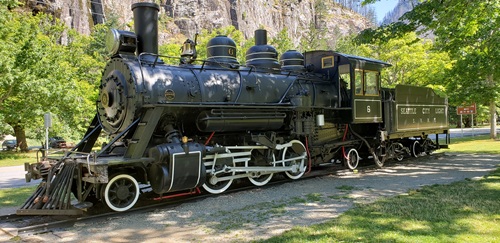
Source: Author.
Elsewhere, though, Lang’s writing demonstrated that he and the B&O had plenty of room left in terms of civil engineering innovation and advancement. While he referenced discussions of site exploration from previous sections of Foundations, Abutments and Footings, he gave only passing coverage to a number of what are now considered geotechnical topics. Lang’s 1922 Transactions of ASCE paper on his railroad’s Allegheny River Bridge also reflects this perspective, as he spent just 2 of his article’s 25 pages on the structure’s foundation engineering. Edward Stearns, a civil engineer who had been the American Bridge Company’s field supervisor on the structure, added his two cents during ASCE’s discussion of the paper. He congratulated Lang but also added detail on some geotechnical angles of the story, including the installation of Simplex concrete piles at some pier locations and the excavation of pneumatic caissons through poor-quality shale bedrock at others. Lang replied politely but with palpable impatience that discussion of such “accessory detail” about the job could only distract readers from “those features of general operation that might be of professional interest and merit treatment in a published article.” His jarring, dismissive remark helps explain the relatively scarce coverage of some geotechnical subjects in his portion of Section 7 (Lang 1922, Lang and Stearns 1922, Lang and Young 1923).
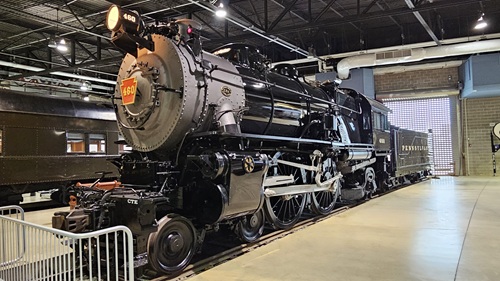
Source: Author.
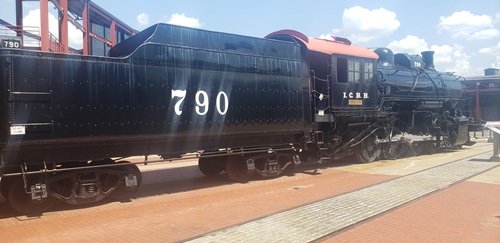
Source: Author.
Lang stated that buoyancy “rarely” compromised the stability of bridge piers and that “generally the neglect of buoyancy will be on the side of safety.” Modern geo-professionals, painfully cognizant of the principle of effective stress, will beg to differ.
Philip Lang covered some geotechnical topics in more detail within Section 7 of Foundations, Abutments and Footings. However, his treatments of them were often riddled with mistakes that, in hindsight, indicate where the geotechnical advances of the next 100 years would unfold. For example, Lang stated that buoyancy “rarely” compromised the stability of bridge piers and that “generally the neglect of buoyancy will be on the side of safety.” Modern geo-professionals, painfully cognizant of the principle of effective stress, will beg to differ. Later, Lang accurately stated that “the dimensions of [pier] foundations” depended upon “the load in tons per square [foot] which it has been determined in advance” that the “underlying material” could support. However, he could provide his readers no further guidance on this point, as scientifically rigorous methods for making this determination were just gaining traction in 1923 [see Hool and Kinne (1923), Section 3, Part A]. Finally, when Lang discussed the evaluation of lateral earth pressures on bridge abutments, he correctly noted the importance of ensuring adequate drainage behind them using rock backfill and a network of drainage pipes. However, he also explained (citing the theories of Coulomb and Rankine) that all mathematical treatments of lateral earth pressure at that time incorporated a planar failure surface, a resultant force applied one-third of the way up the wall, and a predefined orientation of this resultant. Modern geo-professionals recognize from subsequent geotechnical advances that the assumptions Lang listed often fall short of the mark. Most notably, the failure surface in passive earth pressures within cohesive soils is best represented using a logarithmic spiral, and the effects of soil arching often elevate the point at which a resultant force acts significantly above one-third of a wall, abutment, or excavation height (Lang and Young 1923, Terzaghi et al. 1996).
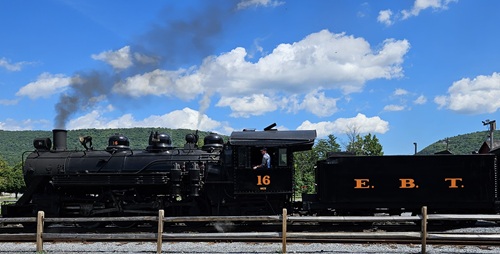
Source: Author.

Source: Author.
Philip Lang’s discussion of the scour of bridge piers in Section 7 of Foundations, Abutments and Footings illustrates more clearly than any other topic he covered both his efforts to handle geotechnical considerations using practicing experience and thinking around corners and how such efforts ultimately come up short when founded on inadequate theoretical knowledge. The proportion of US bridge failures attributable to scour in 1923 was probably even higher than the 60% it is today. By the Roaring Twenties, the fundamental mechanism driving scour at bridge piers was at least well understood. When water flows around an obstruction such as a pier, it accelerates up to 50% to maintain a constant flow rate and picks up material around the pier en route. To combat scour, Lang suggested minimizing this acceleration by building the pier as orthogonally to the channel as was practical, with its shorter side facing upstream. He also recommended that engineers shape this short side into either a semicircle, which he preferred and had used on the B&O’s Allegheny River Bridge, or an isosceles triangle with 45° angles from the main body of the pier. Clearly, Lang appreciated how crucial scour considerations were in safely conveying his railroad’s trains between its ornate terminals in cities such as Baltimore, Cincinnati, and Philadelphia. Still, he did not yet fully understand the nature of the problem (Briaud 2023, Lang 1922, Lang and Young 1923).

Source: LOC (2025).
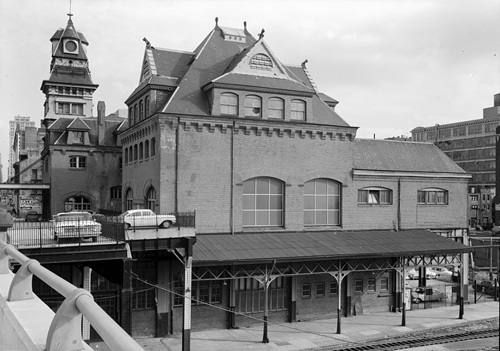
Source: LOC (2025).
A century onwards, detailed research has made the mechanics and parameters governing scour much better understood. The erosion threshold at which soil undergoes scour can now be expressed as either a critical flow velocity, vc, or a critical shear stress, τc, both of which can be empirically correlated to a soil’s type and mean grain size, D50. More granular soils usually undergo scour to peak depth more rapidly (in hours) than more cohesive ones (in days), albeit to a lesser maximum depth. For a bridge pier in a waterway, the maximum depth of scour may be predicted using the following equation:
zmax (pier) = 2.2 × B′ × Kpw × Kpsh × Kpa × Kpsp × (2.6 × Fr[pier] – Frc[pier]) 0.7
Within this equation, B′ is the pier’s projected width perpendicular to waterway flow; Kpw accounts, as applicable, for the reduced scour potential of shallow water; Kpsh accounts for the pier’s end or nose shape; Kpa is the pier’s aspect ratio (length to base); Kpsp accounts for pier spacing; and Fr[pier] and Frc[pier] are, respectively, the current and critical Froude numbers for the waterway. The pier end shape factor, Kpsh, has been defined through repeated study as 0.9 for sharp pier noses, 1.0 for round or circular noses, and 1.1 for square noses. Thus, Philip Lang was mistaken in preferring semicircular noses over sharp noses for his bridge piers, but he did correctly identify the two most favorable nose shapes for minimizing scour. An analogous equation and factors have been developed for scour at bridge abutments, where the abutment shape factor, Kash, steadily decreases when going from vertical wall abutments to a standard wingwall abutment to spill-through abutments with sloped aprons. This intuitively makes sense, since vertical abutments reduce a channel’s flow area, thus increasing velocity and scour. It also represents a sea change from the guidance Lang offered on bridge abutment design, in which he made no reference at all to scour (Briaud 2023, Browne et al. 2010, Lang and Young 1923).
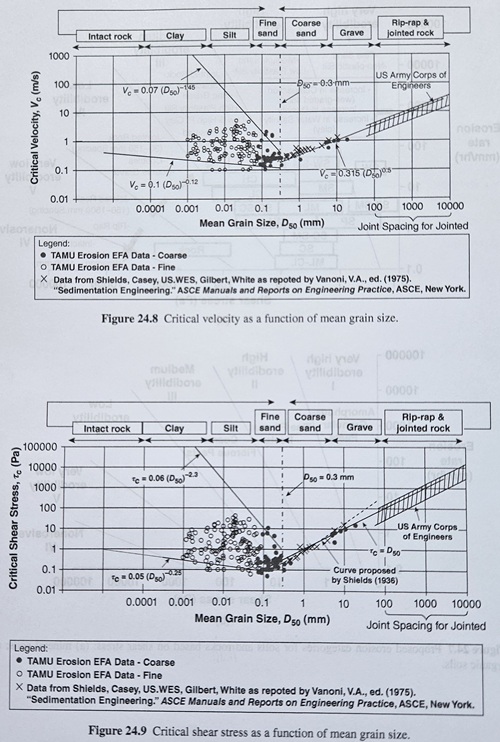
Source: Briaud (2023).
Once structures are built, their geotechnical stability against scour is regularly monitored. Scour inspection procedures, another topic Philip Lang left unaddressed, were standardized in the US after several high-profile, fatal bridge failures from scour in the late 1980s. Scour is usually evaluated every two years during a bridge’s federally mandated inspection, and additional checks are often performed following major flood events. Engineers trained as both divers and inspectors use either surface-supplied air or SCUBA gear as they evaluate piers. Surface air supplies permit work at greater depths, in stiffer currents, and for longer durations, but SCUBA gear allows for several dives to be undertaken in quick succession – advantageous for inspecting a multi-pier structure – and eliminates the tangling hazard of a surface air supply umbilical. The divers will be well-positioned to observe horseshoe vortices swirling at the upstream bases of bridge piers and excavating horseshoe-shaped depressions (hence their name) of material there. While the divers ply their trade, additional inspectors on the water’s surface monitor their safety and supplement their work using sensing techniques such as remote operated vehicles, electronic video inspection devices, and imaging systems such as fathometers and side-scanning sonar. These methods can be particularly invaluable under conditions unsafe for human diving inspections, such as fast currents, greater flow depths, or debris-laden water. The surface crew will also watch for other potential indicators of scour, such as the telltale whorls of wake vortices spinning downstream of bridge piers (Ayres Associates 2025, Browne et al. 2010).
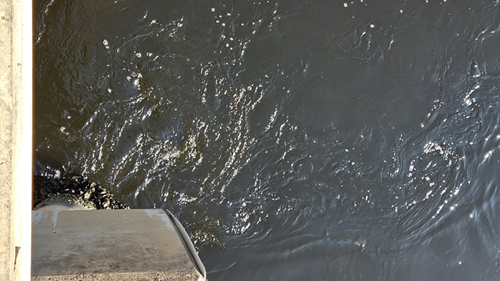
Source: Author.
Back in the office, the diving and surface inspection teams can compare their complementary findings on scour at a bridge. The divers’ notes and photos give an understanding of the bridge’s current condition that only boots on the ground – or, more aptly, fins in the water – can provide. Meanwhile, the surface surveys provide large amounts of subsurface data to contextualize the divers’ observations and cover inherent pitfalls of diving, including often-poor underwater visibility and the limitations of what divers can see within a relatively short window of time. The results of select geophysical methods, such as ground-penetrating radar and low-frequency sonar, can be used to locate pockets of infilled material around bridge piers, which might otherwise provide a false sense of security about their performance with regards to scour. Geo-professionals might instinctively prefer soil borings, but these are costly and tedious to conduct underwater and provide little information on the lateral extent of infilling (Browne et al. 2010).
Eventually, the inspection team will compile their data into cross-section plots of the waterway channel and of the bases of the piers. Critically, the team members will compare these results to those of previous scour inspections to identify any long-term trends in the structure’s scour performance over time. Finally, the team will use their findings together with a detailed descriptive rubric to assess the bridge’s performance against scour on a scale of 0 to 9. A bridge rated 9 is in excellent shape on dry land above flood elevations and is unthreatened by scour, while a bridge rated 0 has failed due to scour. Such a rigorous inspection procedure for scour at bridges would likely have staggered Philip Lang and the B&O Railroad’s fellow civil engineers. Given their employer’s hunger for innovation, though, they might well have moved quickly to implement such protocols on their own bridges (Browne et al. 2010).
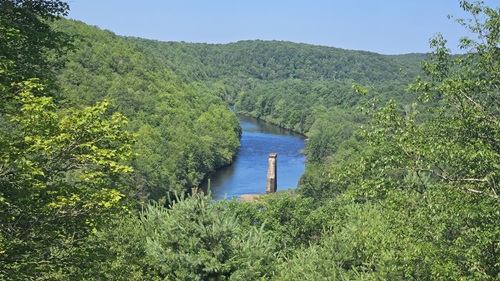
Source: Author.
A century after Foundations, Abutments and Footings was published, evaluating the scour performance of surviving railroad bridge piers and abutments from that time – or, indeed, just about any aspect of their geotechnical performance – is difficult if not outright impossible. The theoretical aspects of the scour and geotechnical design of modern such structures are much more rigorously established, and comparing the work of past engineers to present standards is a far safer proposition than judging that work by those standards. Moreover, survivor bias is at play. Many railroad bridges built in the early 1900s failed due to scour or other design flaws, and those that survive from back then reflect some mix of design conservatism, robust construction, careful maintenance, and happenstance. Furthermore, plenty of robustly built railroad bridges met the wrecking ball later in the 1900s as the American rail industry collapsed (see Image 23). Given all that, the number of US railroad bridges from the early 20th century that remain in service is truly remarkable. Many have endured far beyond their intended lifespans despite dramatically increasing loads and decades of deferred maintenance. Only now in their perilously old age, often well over 100 years, are many of these bridges being replaced. One prominent example is the Portal Bridge on the former Pennsylvania Railroad, the B&O’s archrival, near Kearny, NJ. The structure, built in 1907 as part of the Pennsy’s extension into Manhattan, is finally being replaced through Amtrak’s Gateway Project. (Disclosure: The author worked on this project.)
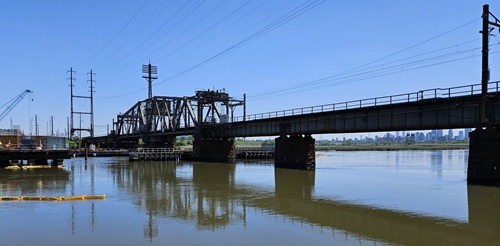
Source: Author.

Source: Author.
Perhaps not coincidentally, the bridges engineered by Philip Lang and Hugh Young have long outlasted both men and their respective employers. Most of the structures Young and his colleagues at the Chicago Bascule Bridge Company designed continue to carry daily automotive traffic in Chicago and other US cities. The same holds true for the bridges Lang and his B&O peers crafted. Lang’s and Young’s writings in Section 7 of Foundations, Abutments and Footings make clear that they ably, albeit not always, compensated for their lack of theoretical know-how and their occasional aversion to divulging trade secrets with practical, experience-driven solutions to problems and the ability to adeptly think on their feet. The lesson remains an invaluable one for rookie geo-professionals (Lang and Young 1923).
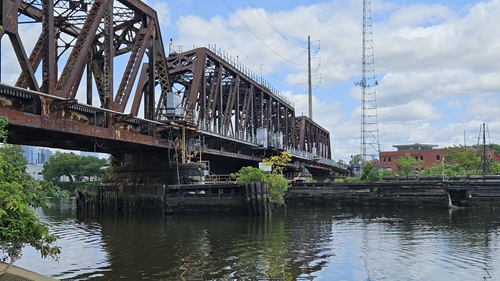
Source: Author.
Lang’s peer civil engineers at the Baltimore and Ohio Railroad certainly appreciated his knack for creativity and innovation, and their employer fostered a culture in which they were similarly encouraged to push the limits of practice in their field. These innovative ways almost surely played a sizable role in keeping the B&O afloat. The 1960s and 1970s marked the nadir of the American railroad industry (see Hool and Kinne (1923), Section 4), and the B&O was forced to take drastic measures to stay solvent. It ended passenger service on the Royal Blue in 1958 and demolished its Philadelphia station on Chestnut Street a few years later. (A mural of the station now stands by the site.) Most notably, the B&O followed most other major railroads in the northeast US and merged to keep above water – in its case with another old rival, the Chesapeake and Ohio, in 1972. However, the newly expanded C&O bucked the economic trends of the day and, unlike almost every other major railroad then in the region, thrived after the merger (York 1987).

Source: Author.
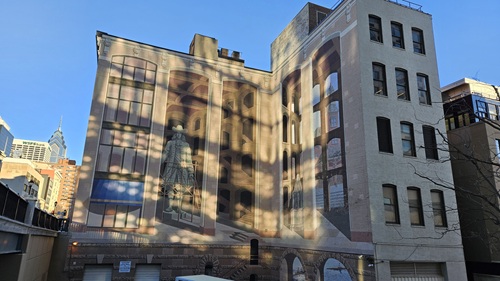
In 1980, the new C&O merged again, this time with the Seaboard Railroad. The merged company took the name CSX – C for C&O, S for Seaboard, and X for the merger’s anticipated multiplier effect. These hopes were realized, as CSX continues to thrive and is now one of the US’s two Class I railroads east of the Mississippi River (the other being Norfolk Southern). Following the July 2025 announcement of advanced merger talks between Norfolk Southern and Union Pacific, which would create the United States’ first transcontinental railroad carrier, industry insiders have stated that CSX and BNSF (formerly the Burlington Northern and Santa Fe Railroad) are engaged in similar discussions. If such a merger took place, it would make for quite the celebration of the B&O’s upcoming bicentennial in 2027 (Valle 2025, York 1987).
The B&O lives on in several ways in addition to CSX’s corporate heritage. Many of its structures remain in service, such as its 1910 bridge over the Schuylkill River in Philadelphia, (see Image 26). It is unknown whether Philip Lang worked directly on this structure but is distinctly possible. Other, less apparent remnants of the railroad also turn up from time to time. When Philadelphia’s Chestnut Street Bridge over the Schuylkill River, just 2 miles northeast of the B&O’s bridge, was reconstructed recently, crews found that the demolition contractor that tore down the railroad’s station there in 1963 had saved money by burying the B&O’s stone staircases from street level to track level rather than properly demolishing them. The project team took the opportunity to preserve the staircases for history by first photographing them and then reburying them beneath the new bridge’s eastern approach to seal them off from natural deterioration. The team also rehabilitated the stone-arch overpass carrying Chestnut Street over 24th Street, which the B&O had built as part of its station project, and reopened one of the railroad’s two sidewalk tunnels beneath Chestnut Street for regular bicycle and pedestrian traffic (Meyers and Spivak 2010, Rehrig and Sirignano 2023).

Source: Jessica Rehrig, P.E. (Alfred Benesch & Co.).
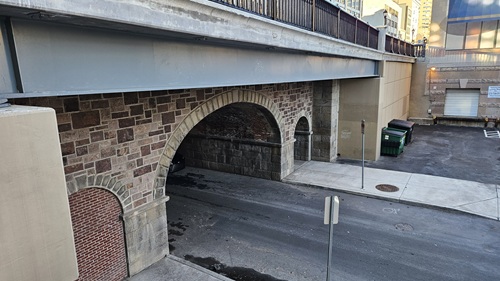
Source: Author.
...great engineering, or even a new approach to it, doesn’t have to be overly elaborate or intricate; it merely needs to be sound and workable.
As CSX trains continue to rumble over the bridges Philip Lang and his peers designed for the B&O, the railroad’s history has also been preserved more systematically. The B&O Railroad Museum at the line’s original Baltimore terminus ably chronicles the railroad’s rich heritage. The exhibits speak to the hard work and dedication of early 20th-century civil engineers such as Lang who compensated, often successfully, for their lack of technical geotechnical know-how with abundant ingenuity and tenacity, along with sturdy construction. Their work shows that great engineering, or even a new approach to it, doesn’t have to be overly elaborate or intricate; it merely needs to be sound and workable. The ability of Lang, his peers, and their predecessors and successors at the railroad to break problems down to their basics, consider solutions outside the box, and bring those solutions into being explains as much as anything else the success and durability of the Baltimore and Ohio Railroad and its corporate successors.
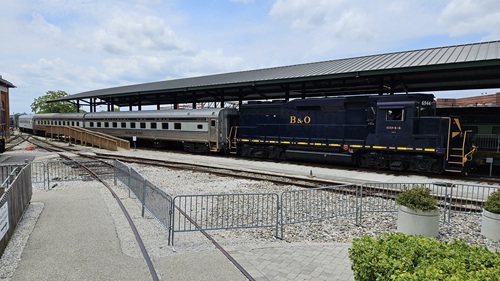
Source: Author.
Acknowledgments
Sebastian Lobo-Guerrero, Ph.D., P.E., BC.GE, F.ASCE (A.G.E.S., Inc.: Canonsburg, PA), the author’s former colleague, reviewed the entry’s geotechnical content. Thomas Kennedy (Geopier: Davidson, NC), the author’s Virginia Tech classmate, co-authored a 2021 version of the entry posted on an independent webpage. Prof. Jean-Louis Briaud, Ph.D., P.E., BC.GE, Dist.M.ASCE, Pres.21.ASCE, (Texas A&M University: College Station, TX) allowed the use of Image 21. Marianna Fleming, P.E. (Marine Solutions, Inc.: New York, NY) shared several sources on bridge scour and scour inspection. The author’s former colleagues at GFT (Valley Forge, PA), allowed the use of Images 24 and 25, which he had taken on assignment there. Jessica Rehrig (Alfred Benesch & Co.: Allentown, PA) shared and allowed the use of Image 29. Finally, Kevin Delano, Ph.D. (Goddard Space Flight Center: Greenbelt, MD), the author’s Lafayette College roommate, provided valuable historic perspective while patiently accompanying him on separate trips to the Baltimore and Ohio Railroad Museum (Baltimore, MD), the former site of the B&O’s Philadelphia station (Philadelphia, PA), the National Museum of American History (Washington, DC), and the Railroad Museum of Pennsylvania (Strasburg, PA).
References
Ayres Associates. 2025. “Roberts and Dona Bay Trail Bridge Replacements.” Ayers Associates, Inc. Accessed Jul. 28, 2025. https://www.ayresassociates.com/project/roberts-and-dona-bay-trail-bridges/
Briaud, J.-L. 2023. Geotechnical engineering: Unsaturated and saturated soils, 2nd ed. Hoboken, NJ: John Wiley and Sons.
Browne, T.M, T.J. Collins, M.J. Garlich, J.E. O’Leary, D.G. Stromberg, and K.C. Heringhaus. 2010. Underwater Bridge Inspection Reference Manual, Pub. FHWA-NHI-10-027. Washington, DC: US Department of Transportation, Federal Highway Administration.
Eliot, T.S. 1925. “The Hollow Men.” The Poetry Hour. Accessed Jul. 6, 2025. https://thepoetryhour.com/poems/the-hollow-men/
Fenton, M. 2004. “The Baltimore and Ohio Railroad: Incubator of engineering entrepreneurs in the nineteenth century.” In 5th Natl. Congr. Civ. Eng. Hist. Heritage, 27-40. Baltimore, MD: American Society of Civil Engineers.
FG (Find a Grave). 2012. “Rev. Benjamin Brewster (1860-1941).” Find a Grave, Jul. 11. Accessed Jul. 6, 2025. https://www.findagrave.com/memorial/93456974/benjamin-brewster
Goodman, R.E. 1999. Karl Terzaghi: The engineer as artist. Reston, VA, USA: ASCE Press.
Hankey, J.P. 2002. “The Baltimore and Ohio Railroad and the origins of American civil engineering.” In 4th Natl. Congr. Civ. Eng. Hist. Heritage, 219-269. Washington, DC: American Society of Civil Engineers.
Lang, P.G. 1922. “The reconstruction of the Baltimore and Ohio Railroad bridge crossing the Allegheny River, at Pittsburgh, Pennsylvania.” Trans. Am. Soc. Civ. Eng., LXXXV (1), Paper 1501, 1152-1176.
Lang, P.G., and E.W. Stearns. 1922. “Discussion and closure: The reconstruction of the Baltimore and Ohio Railroad bridge crossing the Allegheny River, at Pittsburgh, Pennsylvania.” Trans. Am. Soc. Civ. Eng., LXXXV (1), 1177-1180.
Lang, P.G., and H.E. Young. 1923. “Section 7: Bridge piers and abutments.” In Foundations, Abutments and Footingss, G.A. Hool and W.S. Kinne, eds. New York, NY: McGraw-Hill, 315-353.
LOC (Library of Congress). 2025. “Baltimore & Ohio Railroad station, Twenty-fourth and Chestnut Streets, Philadelphia, Philadelphia County, PA: Photos from Survey HABS PA-1220.” Library of Congress – Photo, Print, Drawing. Accessed Jul. 28, 2025. https://www.loc.gov/resource/hhh.pa1097.photos/?sp=1&st=gallery
Marx, K., 1867. Das Kapital (Capital). “Chapter 28: Bloody legislation against the expropriated.” Pepperdine Univ. School of Public Policy. Accessed Jul. 6, 2025. https://publicpolicy.pepperdine.edu/academics/research/faculty-research/intellectual-foundations/marx-engels/marx_part8.htm
Marquis, A.N. 1922. Who’s who in engineering: a biographical dictionary of contemporaries. Chicago, IL, USA: A.N. Marquis and Co.
McCullough, D. 1972. The great bridge. New York, NY: Simon & Schuster.
Meyers, A., and J. Spivak, J. 2010. Images of rail: Philadelphia railroads. Charleston, SC: Arcadia Publishing.
Prentis, E.A., and White, L. 1931. Underpinning. New York, NY: Columbia University Press.
Quote Investigator (QI). 2012. “Quote origin: I really didn’t say everything I said.” Quote Investigator, Dec. 30. Accessed Jul. 6, 2025. https://quoteinvestigator.com/2012/12/30/yogi-didnt-say/
Quote Investigator (QI). 2018. “Quote origin: In theory there is no difference between theory and practice, while in practice there is.” Quote Investigator, Apr. 14. Accessed Jul. 6, 2025. https://quoteinvestigator.com/2018/04/14/theory/
Rehrig, J., and J. Sirignano. 2023. “Chestnut Street Bridge rehabilitation project.” Presentation. King of Prussia, PA: American Society of Highway Engineers, Delaware Valley Section.
Rizzo, J. (Ed.). 2004. National Geographic historical atlas of the United States. Washington, DC: National Geographic Society.
Terzaghi, K., R.B. Peck, and G. Mesri. 1996. Soil mechanics in engineering practice, 3rd ed. New York, NY: John Wiley and Sons.
Texas A&M University Engineering (TAMU). 2024. “Home: About our blog.” Ingenium, Texas A&M University. Accessed Jul. 6, 2025. https://ingenium.engr.tamu.edu/about-ingenium-blog/
Thayer, W.W. 1892. “The Philadelphia tunnel of the Baltimore and Ohio Railroad; its construction and cost.” Trans. Am. Soc. Civ. Eng., XXVI (1), Paper 532, 529-534.
Valle, S. 2025. “Union Pacific talks advance, regulator readies for historic rail merger review.” Reuters, Jul. 24. Accessed Jul. 25, 2025. https://www.reuters.com/world/us/union-pacific-talks-advance-regulator-readies-historic-rail-merger-review-2025-07-24/
York, T. 1987. North America’s Great Railroads. Greenwich, CT: Brompton Books Corporation.
